![]()
![]()
![]()
Use LEFT and RIGHT arrow keys to navigate between flashcards;
Use UP and DOWN arrow keys to flip the card;
H to show hint;
A reads text to speech;
37 Cards in this Set
- Front
- Back
- 3rd side (hint)
|
Define antigen. |
Contraction of antibody generating |
Break down the word |
|
|
How many types of RBCs are there? |
4- A,B,AB,O |
Blood types |
|
|
What percentage of formed elements in blood are RBCs? |
99.9% 25/75 trillion cells |
|
|
|
What makes RBCs unique? |
Very specialized, no nucleus or mitochondria, shape |
Purpose is to deliver oxygen |
|
|
Define anemia |
When RBCs make up less than 99.9% of formed elements |
|
|
|
How many types of WBCs are there and what are they named? |
5 - Neutrophils, Eosinophils, Basophils, Monocytes, Lymphocytes |
Never let monkeys eat bananas |
|
|
Define hemostasis |
Proper term for blood clotting |
Medical terminology |
|
|
Superior and inferior venae cavae, and pulmonary trunk |
What 3 structures feed into the right atrium? |
|
|
|
What are the 5 functions of blood? |
Transport (gases, nutrients, hormones, waste) Regulate pH Restrict fluid loss in the event of injury Defend against toxins and pathogens Stabilize body temperature |
|
|
|
What is the normal temperature for blood? |
38 degrees centigrade |
|
|
|
Normal blood pH is: |
Between 7.35 and 7.45 |
|
|
|
2 main types of lymphocytes and where they are formed |
T-cells - thymus - cell mediated immunity (against invading foreign cells, and coordination of immune response) B-cells - bone - humoral immunity (activated bcells differentiate into plasma cells specialized to synthesize and secrete antibodies) |
|
|
|
Blood has a viscosity roughly _× that of water |
5 |
|
|
|
Autorythmicity |
Ability of the heart to contract on its own, without neural or hormonal stimulation |
|
|
|
3 defenses for when iron is released from it's heme group; |
First bind to transferrin 1)RBCs in red bone marrow absorb them to synthesize new Hb molecules 2) excess transferrin removed in the liver and spleen and stored in ferritin and hemosiderin 3) can be stripped of its ion and converted into bilirubin |
Check with Stephanie |
|
|
Neutrophil (50-70%) |
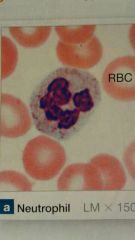
Primary infection fighter First on scene Highly mobile Phagocytic- attack and kill marked bacteria Engulf bacteria>respiratory burst>production of hydrogen peroxide and superoxide anions>degranulation Increase capillary permeability Release leukotrienes |
|
|
|
Lymphocytes (20-40%) |
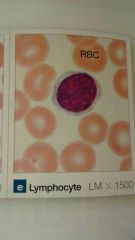
Very active between blood stream and peripheral tissues Tcells, Bcells, NKcells |
|
|
|
Monocytes (2-8%) |
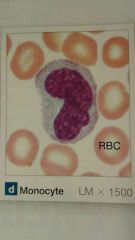
Circulate in bloodstream for 24 hours then enter peripheral tissue and become macrophage Can consume items as large as themselves Engage in chemotaxis - attract and stimulate WBCs, and bring in fibroblasts to create scar tissue |
|
|
|
Eosinophil (2-4%) |
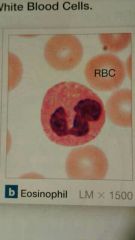
Attack objects coated in antibodies (masked bacteria, protozoa) Primary attack- exocytosis of toxic compounds- especially effective against multicellular parasites (flukes and roundworm) Sensitive to allergens so increase during allergic reactions |
|
|
|
Basophil (<1%) |
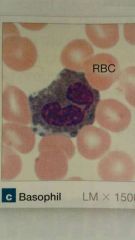
Contain histamines which dilate blood vessels, and heparin which prevents clotting |
|
|
|
Macrophage |
Aggressive phagocyte |
|
|
|
Formula for cardiac output |
CO mL/min =HR (beats/min) × SV (mL/beat |
|
|
|
Formula for stroke volume |
SV=EDV-ESV (End diastolic volume - end systolic volume) |
|
|
|
ECG section |
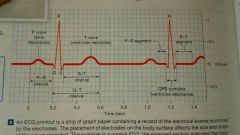
|
|
|
|
Erythropoiesis |
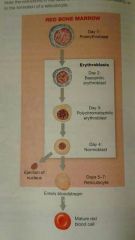
Formation of RBCs |
|
|
|
Erythropoietin |
Hormone which directly stimulates erythropoiesis Produced in kidneys and liver in response to low oxygen levels in peripheral tissues (hypoxia) Stimulates cell division in erythroblasts and speeds up maturation of RBCs |
|
|
|
Conditions that stimulate RBC production |
Hypoxia (low oxygen levels) Anemia Blood flow to kidneys declines Respiratory surfaces of lungs are damaged Oxygen content of lungs decreases |
|
|
|
Impulse conduction through heart |
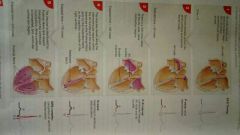
|
|
|
|
Phases of cardiac cycle |

|
|
|
|
Bonus points |

|
|
|
|
Heart anatomy |
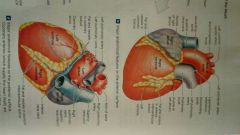
|
|
|
|
Sectional anatomy |
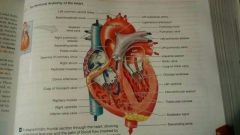
|
|
|
|
Leaky valves |
What causes a murmur |
|
|
|
Differences in fetal heart |
1) foramen ovule- opening in interatrial septum connecting the two atria, closes at birth, allows blood flow between atria while lungs are developing 2) |
|
|
|
3 cardiac muscle layers |
Epicardium, mayocardium, endocardium |
|
|
|
Cardiac muscle ratio |
99:1 contracting: conducting |
|
|
|
Platelets |
Disc shaped cell fragments Function: release important to clotting Form temporary patch in walls of damaged vessels (Platelet plug) Reduce size of break in vessel wall (actin and myosin filaments) |
|

